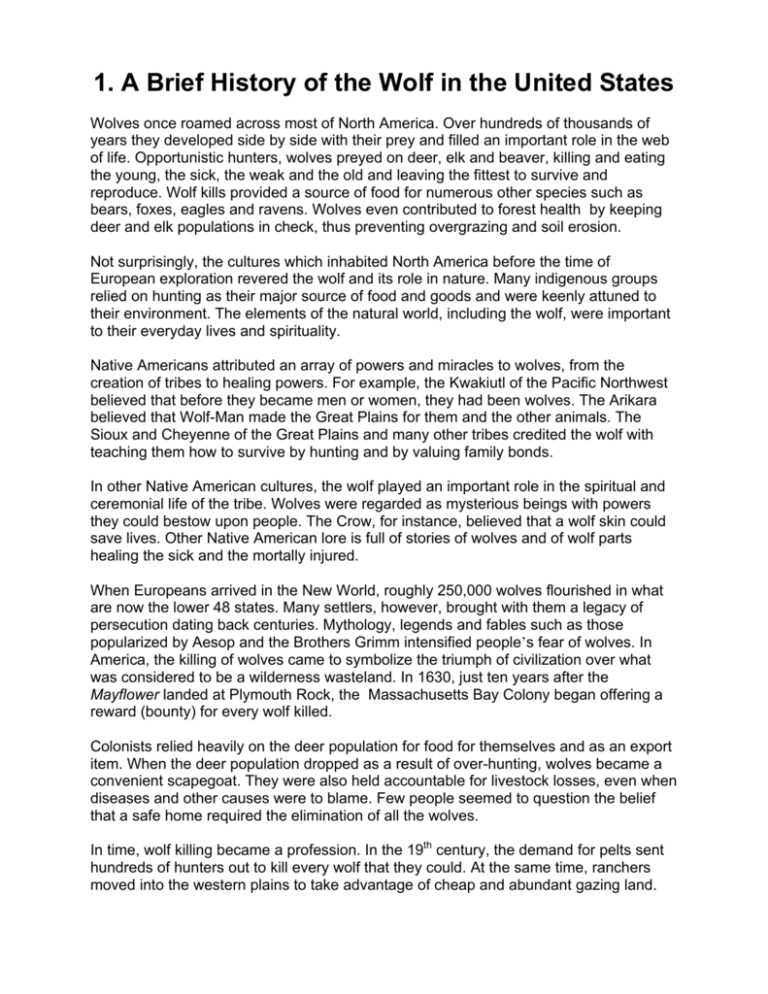A Brief History of the Wolf in the United States
advertisement

1. A Brief History of the Wolf in the United States Wolves once roamed across most of North America. Over hundreds of thousands of years they developed side by side with their prey and filled an important role in the web of life. Opportunistic hunters, wolves preyed on deer, elk and beaver, killing and eating the young, the sick, the weak and the old and leaving the fittest to survive and reproduce. Wolf kills provided a source of food for numerous other species such as bears, foxes, eagles and ravens. Wolves even contributed to forest health by keeping deer and elk populations in check, thus preventing overgrazing and soil erosion. Not surprisingly, the cultures which inhabited North America before the time of European exploration revered the wolf and its role in nature. Many indigenous groups relied on hunting as their major source of food and goods and were keenly attuned to their environment. The elements of the natural world, including the wolf, were important to their everyday lives and spirituality. Native Americans attributed an array of powers and miracles to wolves, from the creation of tribes to healing powers. For example, the Kwakiutl of the Pacific Northwest believed that before they became men or women, they had been wolves. The Arikara believed that Wolf-Man made the Great Plains for them and the other animals. The Sioux and Cheyenne of the Great Plains and many other tribes credited the wolf with teaching them how to survive by hunting and by valuing family bonds. In other Native American cultures, the wolf played an important role in the spiritual and ceremonial life of the tribe. Wolves were regarded as mysterious beings with powers they could bestow upon people. The Crow, for instance, believed that a wolf skin could save lives. Other Native American lore is full of stories of wolves and of wolf parts healing the sick and the mortally injured. When Europeans arrived in the New World, roughly 250,000 wolves flourished in what are now the lower 48 states. Many settlers, however, brought with them a legacy of persecution dating back centuries. Mythology, legends and fables such as those popularized by Aesop and the Brothers Grimm intensified people’s fear of wolves. In America, the killing of wolves came to symbolize the triumph of civilization over what was considered to be a wilderness wasteland. In 1630, just ten years after the Mayflower landed at Plymouth Rock, the Massachusetts Bay Colony began offering a reward (bounty) for every wolf killed. Colonists relied heavily on the deer population for food for themselves and as an export item. When the deer population dropped as a result of over-hunting, wolves became a convenient scapegoat. They were also held accountable for livestock losses, even when diseases and other causes were to blame. Few people seemed to question the belief that a safe home required the elimination of all the wolves. In time, wolf killing became a profession. In the 19th century, the demand for pelts sent hundreds of hunters out to kill every wolf that they could. At the same time, ranchers moved into the western plains to take advantage of cheap and abundant gazing land. As domestic livestock replaced the wolf’s natural prey base of bison and deer, the threat of wolf predation on cattle led to a massive campaign to exterminate the wolf in the American west. Professional “wolfers” working for the livestock industry laid out strychnine-poisoned meat lines up to 150 miles long. When populations dropped to such low levels that wolves were difficult to find, states offered bounties with the goal of extirpating wolves altogether. Wolves were shot, poisoned, trapped, clubbed, set on fire and inoculated with mange, a painful and often fatal skin disease caused by mites. In a 25-year period at the turn of the century, more than 80,000 wolves were killed in Montana alone. Well into the 20th century, the belief that wolves posed a threat to human safety persisted despite documentation to the contrary. The persecution continued. By the 1970s, only 500 to 1,000 wolves remained in the lower 48 states, occupying less than three percent of their former range. Fortunately, America’s understanding of the wolf has grown in the last 20 years. As scientists have discovered more about the intricacies of nature, our knowledge of the interdependence of all living things has increased significantly. People are now more aware of the importance of predators in maintaining healthy ecosystems. In addition, as our population has become increasingly urbanized and wilderness areas have been swallowed up by development, we have begun to treasure what we are losing. The wolf has become a symbol of our loss. The overwhelming number of wolf advocacy groups that now thrive in the United States attest to the degree to which these predators have captured our interest and our imagination. Thanks to efforts by the U.S. Fish and Wildlife Service, zoos and wildlife advocacy groups, wolves have slowly begun to recover in areas where they have long been absent. In recent years, wolves have been successfully reintroduced to former habitats in central Idaho, Wyoming, Montana, North Carolina and Arizona. More than 5,000 wolves now inhabit the wild south of Canada. While many welcome this recovery, a vocal minority remains strongly opposed to the presence of any wolves at all in the wild. The truth about wolves must get out if recovery efforts are to continue. The lessons in this curriculum will help you discover the truth about wolves and decide for yourself whether or not wolves and humans can peacefully co-exist. Check Your Reading Skills A Brief History of the Wolf in the United States Short Answer Questions 1. List some of the ways the wolf fills an important role in the web of life. 2. Why did the early colonists seek to destroy the wolf? List at least three reasons. 3. When was the first wolf bounty offered? 4. What was a “wolfer?” What methods were used to exterminate wolves? 5. How successful was the effort to eliminate wolves from the lower 48 states?







